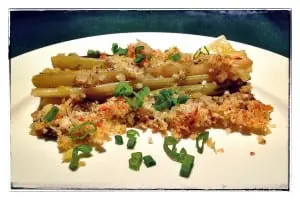By Joe Dizney
I was recently invited to moderate (along with Katherine Whiteside, my counterpart culinaire from the PCNR) a discussion on “Home Economics for The New Age,” as part of the Hudson Highland Land Trust’s 2015 Sustainability Forum, scheduled for April 19.
Why I, an aging, childless male who lives alone 75 percent of the time, was asked to function as some sort of authority on the topic is a question only they can answer. But as a self-employed, card-carrying member of the economic 99 percent, I do have an active concern and participation in my own personal home economy, and this curious turn of events got me thinking about macro and micro ideas of “economy” and “sustainability” and how we might frame such a discussion.
As a writer, words mean a lot to me, and with just a shallow dive I came to the interesting discovery that the word economy, derived from the Greek oikonomia (oikos means home, dwelling place, habitation, and nemein means management) actually makes the concept home economy a redundancy.
Further thickening this conceptual soup, I also found that the word ecology (oikos means house and logia is study of) is fundamentally related — the study and awareness of the place where we live — ultimately pointing to the need for an overarching ecosophy (oikos and sophia mean wisdom, insight, intelligence) or philosophy to deal with this home in a responsible and sustainable manner.
What’s that got to do with a recipe column? What we eat — where it comes from, how it’s grown and brought to market, what it costs in so many ways — ultimately has an impact and meaning, personally, socially and environmentally. It’s all related and it takes work, planning and thought — there is no app for this. But, this knowledge should be an engaging challenge, not a penance or joyless austerity and hardship. It begs a mindfulness of critical issues that affect us all, but also offers myriad possibilities within the ecology of self, spirit, society and environment.
In the culinary sphere, this thinking has recently produced some rather theatrical responses: New York’s Blue Hill restaurant recently mounted a “pop-up” experience called WasteED to “reimagine” restaurant waste, creating cuisine from the bits that are usually discarded from upscale establishments; in her new cookbook Gabrielle Hamilton of the restaurant Prune includes a chapter called “Garbage” with recipes that utilize the hard rinds of Parmesan cheese, the tough outer leaves of leeks, expired heavy cream and the like. While this smacks of look-at-me cleverness and media-grabbing confrontation, the intent is sincere.
Bringing these ideas home just required a look at my own vegetable bin. Celery: I usually buy a whole head for use in numerous recipes (the mirepoix is your friend) but most only require an outer stalk or two at most. And although I’ve mastered the art of keeping the remainder fresh for a while (wrapped in a barely-moistened paper towel, loosely stored in a recycled plastic bag), invariably there is surplus that can hang around long enough to find its way to the compost bin.

This week’s celebratory (no pun intended) recipe utilizes the whole head, to which I’ve added leeks (aka “poor man’s asparagus”) and green onions that were also lurking in my larder. Prepared with a handful of common ingredients available in a well-stocked pantry and served as a side dish to a simple roast chicken or Parmesan risotto, this is a surprisingly tasty, elegant and economical meal.
Braised Celery, Leeks and Other Onions
½ hour prep; 1 ¾ hours cooking; serves 6
1 head celery
6 medium leeks
1 bunch green onions
4 tablespoons olive oil (or 2 tablespoons oil plus 2 tablespoons butter)
1 large shallot, chopped fine
½ teaspoon dried chopped thyme
1 cup water or broth (chicken or vegetable)
1 to 2 tablespoons fresh lemon juice
½ cup grated cheese (Gruyere, Parmigiano-Reggiano or a combination)
4 tablespoons unseasoned breadcrumbs
Preheat oven to 325 degrees. Butter an 8-by-8-inch baking dish and set aside. Remove the large outer stalks (you should have 10 to 12) from the celery, reserving the pale white heart and leaves. Wash, dry and trim the large stalks to fit the baking dish. Remove the base from the heart and finely chop it and the leaves and set aside.
Trim the root end of the leeks as tightly as possible without separating the base. Peel off the tough leaves and trim the tops just short of where they get dark and leathery (no longer than the baking dish; shorter is OK). Reserve the dark greens for stock. Cut leeks in half lengthwise and rinse thoroughly under cold water, flaring the layers to remove grit. Shake to remove moisture and dry. Halve them again and layer with the celery stalks in the baking dish.
Wash and dry the green onions; trim the root end as per the leeks, cut to fit dish and layer with celery and leeks. Chop and reserve excess greens for garnish.
In a medium saucepan, heat oil over medium-high heat. Add shallots and thyme; sauté until shallots are translucent. Add chopped celery hearts/leaves and sauté for another 3 to 5 minutes, until soft. Add water or broth and raise heat to reduce liquid by half. Salt and pepper to taste. Stir in lemon juice. Remove from heat and pour over the vegetables in the baking dish. Cover dish tightly with foil; braise in center of oven for 1 ½ hours.
Remove from oven; increase heat to 400 degrees. Mix cheese and breadcrumbs and sprinkle evenly over top of vegetables. Return to oven and bake uncovered for 10 to 15 minutes, until cheese is melted and top is browned. Serve warm, garnished with reserved green onions.


Nice! Reminds me of a wonderful book I recently read: Tamar Adler’s An Everlasting Meal: Cooking with Economy and Grace.